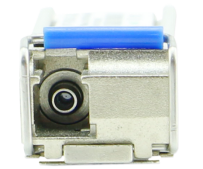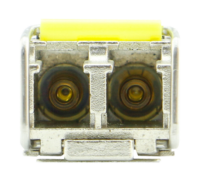As we all know, optical modules are signal transceivers for photoelectric signal conversion. Generally, conventional optical modules convert electrical signals into optical signals at the transmitting end, and then convert the optical signals into electrical signals through the receiving end, so generally two Optical fiber to achieve two-way communication. The BiDi optical module uses an optical fiber to achieve two-way data communication, which means that the BiDi optical module can make the signal travel on the same optical fiber as if driving in two lanes, without interfering with each other. This can greatly increase the network capacity and simplify the wiring system.
Working principle of BiDi single fiber bidirectional optical module
As shown in the figure below, a general optical module has two ports, one for transmitting signals and one for receiving signals, while bidi optical modules have only one port. The bidi optical module can communicate with single fiber and mainly uses WDM (wavelength division multiplexing) technology, which can separate and summarize the data transmitted by different wavelengths. The bidi optical module is filtered by the filter in the optical module to complete one at the same time. The emission of a wavelength optical signal and the reception of another wavelength optical signal. Because the transmission and reception are of different wavelengths, for example, the transmission of 1550nm optical signals and the reception of 1310nm optical signals are completed at the same time, or vice versa, so bidi optical modules must be used in pairs.


The wavelengths of BiDi optical modules are all combinations. The commonly used wavelength combinations are 1310nm/1550nm; 1310nm/1490nm; 1510nm/1590nm. Generally speaking, if the transmission distance is within 40km, the wavelength scheme of the BIDI SFP optical module is 1310nm/1550nm, 1310nm/1490nm; if the transmission distance is above 40km, the wavelength scheme of the BIDI SFP optical module is 1550nm/1490nm.
Advantages of BiDi optical module
Compared with conventional optical modules, BiDi optical modules have the same use effect, but one advantage is that BiDi optical modules do not need so many fibers, which reduces the cost of configuring optical fiber cable infrastructure and also reduces fiber jumpers. The number of ports on the panel requires much smaller space and is easy to manage. It is a better choice for users who lack fiber resources and space.
Although BiDi optical modules are more expensive than traditional dual-fiber bidirectional optical modules, the cost savings of reducing optical fibers is more than spending money on BiDi optical modules. At the same time, dual-fiber optical modules do not need to be paired, and any two optical modules can be connected. The price is cheaper than single-fiber BIDI optical modules, but one more optical fiber is needed. If there is no concern about insufficient fiber resources, you can choose traditional dual-fiber optical Module.
BiDi optical module and ordinary two-way optical fiber module
Through the introduction of the BiDi optical module above, the difference between it and the conventional dual-fiber bidirectional optical module is obvious:
1. The BiDi optical module adopts WDM technology, but the dual-fiber bidirectional optical module does not;
2. BiDi optical modules need to be used in pairs, and dual-fiber bidirectional optical modules can be connected arbitrarily;
3. The structure of the BiDi optical module is more complicated than the dual-fiber bidirectional optical module, and the optical splitter and combiner need to be introduced on the optical module;
4. Only one optical fiber is required between BiDi optical modules, and two dual-fiber bidirectional optical modules are required;
In fact, the use effect of the two is the same, but the BIDI optical module saves fiber resources. You can choose according to your needs.